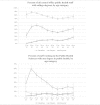Educational Attainment of the Public Health Workforce and Its Implications for Workforce Development
- PMID: 26422495
- PMCID: PMC4590526
- DOI: 10.1097/PHH.0000000000000306
Educational Attainment of the Public Health Workforce and Its Implications for Workforce Development
Abstract
Context: Educational attainment is a critical issue in public health workforce development. However, relatively little is known about the actual attainment of staff in state health agencies (SHAs).
Objective: Ascertain the levels of educational attainment among SHA employees, as well as the correlates of attainment.
Design: Using a stratified sampling approaching, staff from SHAs were surveyed using the Public Health Workforce Interests and Needs Survey (PH WINS) instrument in late 2014. A nationally representative sample was drawn across 5 geographic (paired adjacent HHS) regions. Descriptive and inferential statistics were analyzed using balanced repeated replication weights to account for complex sampling. A logistic regression was conducted with attainment of a bachelor's degree as the dependent variable and age, region, supervisory status, race/ethnicity, gender, and staff type as independent variables.
Setting and participants: Web-based survey of SHA central office employees.
Main outcome measure: Educational attainment overall, as well as receipt of a degree with a major in public health.
Results: A total of 10,246 permanently-employed SHA central office staff participated in the survey (response rate 46%). Seventy-five percent (95% confidence interval [CI], 74-77) had a bachelor's degree, 38% (95% CI, 37-40) had a master's degree, and 9% (95% CI, 8%-10%) had a doctoral degree. A logistic regression showed Asian staff had the highest odds of having a bachelor's degree (odds ratio [OR] = 2.8; 95% CI, 2.2-3.7) compared with non-Hispanic whites, and Hispanic/Latino staff had lower odds (OR = 0.6; 95% CI, 0.4-0.8). Women had lower odds of having a bachelor's degree than men (OR = 0.5; 95% CI, 0.4-0.6). About 17% of the workforce (95% CI, 16-18) had a degree in public health at any level.
Conclusions: Educational attainment among SHA central office staff is high, but relatively few have formal training of any sort in public health. This makes efforts to increase availability of on-the-job training and distance learning all the more critical.
Conflict of interest statement
The authors declare no conflicts of interest.
Figures
References
-
- Gebbie KM, Rosenstock L, Hernandez LM. Who Will Keep the Public Healthy?: Educating Public Health Professionals for the 21st Century. Washington, DC: National Academies Press; 2002. - PubMed
-
- Winslow CE. The untilled fields of public health. Science. 1920;51(1306):23–33. - PubMed
-
- Institute of Medicine. Committee for the Study of the Future of Public Health. The Future of Public Health. Washington, DC: National Academies Press; 1988.
-
- Lenihan P, Welter C, Chang C, Gorenflo G. The operational definition of a functional local public health agency: the next strategic step in the quest for identity and relevance. J Public Health Manag Pract. 2007;13(4):357–363. - PubMed
Publication types
MeSH terms
LinkOut - more resources
Full Text Sources



